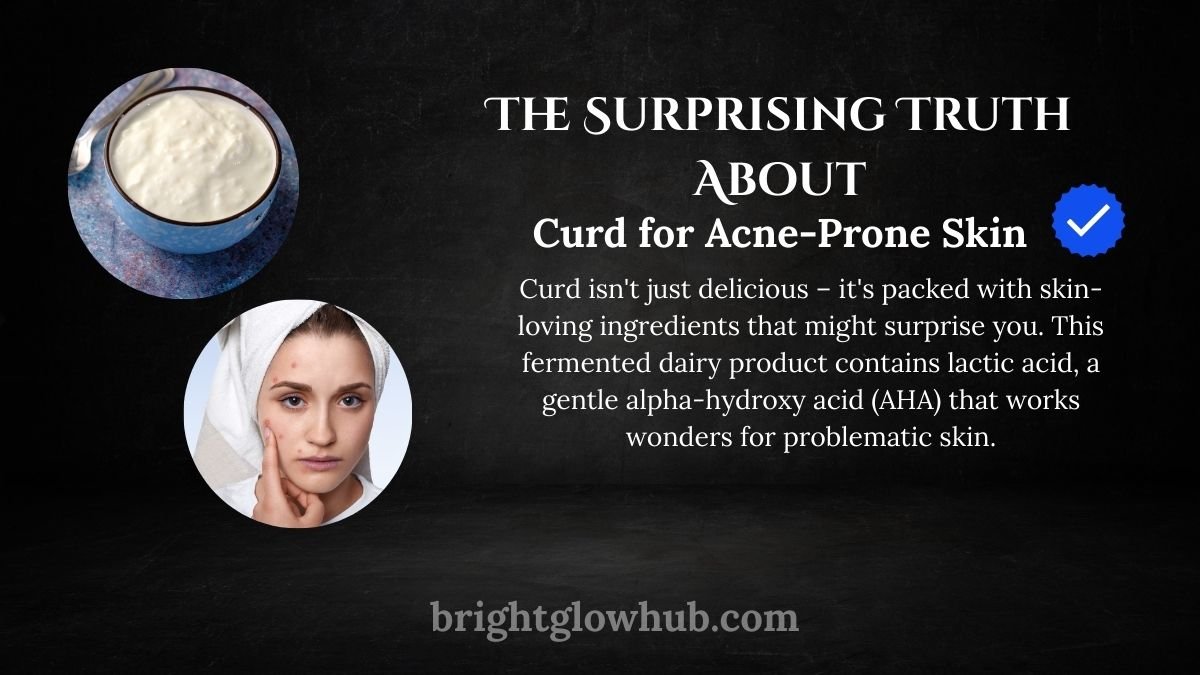Curd for Acne-Prone Skin
If you’ve been dealing with stubborn breakouts and searching for skincare solutions, you might be overlooking something simple in your refrigerator. Yes, we’re talking about curd – that creamy, tangy staple. But can this humble dairy product really play a role in your skincare routine?
⚠️ IMPORTANT DISCLAIMER: We are not dermatologists or medical professionals.
This article discusses a traditional home remedy for informational purposes only.
Results vary greatly between individuals. Always consult a board-certified dermatologist for acne treatment.
Do not use home remedies to replace professional medical care.
Let’s explore the potential benefits and separate fact from fiction when it comes to using curd for skin that is prone to breakouts.
What Makes Curd a Traditional Skincare Ingredient?
Curd isn’t just for eating – it’s packed with ingredients that some people find beneficial for their skin. This fermented dairy product contains lactic acid, a gentle alpha-hydroxy acid (AHA) that is traditionally used by some people for skin care. Think of lactic acid as a potential exfoliating assistant, which may help remove dead skin cells that can sometimes clog pores.
But that’s not all. Curd is also rich in probiotics – those beneficial bacteria known for supporting gut health. When applied to the skin, these probiotics are thought by some to help balance the skin’s microbiome, potentially helping to soothe skin and create an environment that is less favorable for bacteria linked to breakouts.
The Potential Benefits of Curd for Skin

The lactic acid in curd may offer a gentler approach to exfoliation compared to some over-the-counter treatments. It may help unclog pores by dissolving the “glue” that holds dead skin cells together, allowing them to shed naturally instead of building up.
The probiotics in curd are another point of interest. Some research suggests that maintaining a healthy balance of bacteria on the skin can be beneficial. When the skin’s natural barrier is compromised, beneficial bacteria may help support the skin’s health.
Curd also contains zinc and B vitamins, both of which play roles in overall skin health. Zinc has properties that may help soothe skin, while B vitamins support skin cell renewal and repair.
How Some People Use Curd on Their Skin

If you are interested in trying curd, here are some common ways it is used. Remember, individual results vary.
1. The Basic Curd Face Mask
Apply plain, fresh curd directly to clean skin and let it sit for 15-20 minutes before rinsing with lukewarm water. Start with once a week to see how your skin responds.
2. Curd and Turmeric Combo
Mix a tablespoon of curd with a pinch of turmeric powder. This combination is a traditional remedy that some believe adds soothing benefits.
3. Curd and Oatmeal Gentle Scrub
Combine curd with finely ground oatmeal for a mild exfoliating treatment that may be less irritating for sensitive skin.
4. Overnight Spot Treatment
Some individuals dab a small amount of thick curd on individual blemishes before bed. The lactic acid may provide gentle exfoliation overnight.
Important Considerations Before You Try
Before you try this, it’s important to discuss potential sensitivities. If you have a known dairy allergy or sensitivity, applying curd to your skin might not be advisable. Some people find that dairy products, even when used topically, can trigger breakouts or skin irritation.
For best results, always use fresh, plain curd without added sugars or flavors. Consistency is often key with traditional remedies—you may need to use it regularly for several weeks to notice any changes.
Always perform a patch test first! Apply a small amount of curd to your inner wrist or behind your ear and wait 24 hours to ensure you don’t have any adverse reactions.
The Bottom Line
Curd can be a gentle, natural addition to a skincare routine, especially for those looking for a budget-friendly option. Its combination of lactic acid, probiotics, and other compounds may help some individuals with skin that is prone to breakouts.
However, remember that skincare is highly individual. What works for one person might not work for you. The key is to listen to your skin, start slowly, and be patient.
If you decide to try curd, pair it with a gentle cleansing routine, adequate hydration, and sun protection. If you don’t see improvements after 6-8 weeks, or if your skin becomes irritated, it may be time to explore other options or consult with a skincare professional.
Frequently Asked Questions :
How long does it take to see results from using curd on acne-prone skin?
“Individual results vary greatly. Some people report noticing changes within 2-4 weeks of regular use, while others may not see any difference. There is no guarantee of results.”
Can I use Greek yogurt instead of regular curd?
Absolutely! Greek yogurt is actually a great alternative since it’s thicker and contains similar beneficial bacteria and lactic acid. Just make sure it’s plain, unsweetened, and preferably organic.
Is it safe to use curd on sensitive skin?
“Some people find curd to be a gentler option than some commercial products, though this varies by individual and product.”
Should I use homemade curd or store-bought?
Both work well, but homemade curd often contains more active probiotics since it’s fresher. If using store-bought, choose plain varieties without added preservatives or artificial ingredients, and check the expiration date to ensure maximum freshness.
Can I leave curd on my face overnight?
While some people do use curd as an overnight spot treatment, it’s generally not recommended to leave it on your entire face overnight. The lactic acid can cause irritation with prolonged contact, especially for beginners. Stick to 15-20 minutes for full-face applications.
Will curd make my acne worse before it gets better?
Some individuals report experiencing what they call a ‘purging’ phase, though this is not scientifically proven with home remedies. If you experience any new breakouts or irritation, discontinue use immediately and consult a dermatologist.
What’s the best time of day to use a curd face mask?
Evening is generally best, as the lactic acid in curd can make your skin slightly more sensitive to sun exposure. If you do use it during the day, make sure to apply sunscreen afterward.
Disclaimer :
This article is for informational purposes only and does not constitute medical advice. For specific concerns about skin conditions or reactions, please consult a board-certified dermatologist.
Remember to consult with a dermatologist for personalized skincare advice, especially when addressing specific skin concerns
